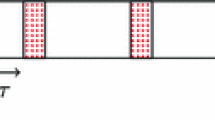Abstract
This paper studies slotted cognitive networks which include multiple spectrum bands and time is divided into slots. In order to increase the opportunity to use idle band, we consider that a secondary user sequentially senses multiple bands within a time slot. To maximize effective throughput excluding sensing overhead, transmission overhead and useless transmission while interference is guaranteed, we shall determine sensing time, frame size, and which band a secondary user sends frames in. We study two sequential sensing policies, namely forward sensing and recall sensing, which determine which band to transmit; the former policy forwardly senses bands one by one, and the latter policy senses a band and records the related information which is used to return back to the band if the effective throughput of other being sensed bands is lower than that of the band. Analyses verified by simulations are developed for the sensing policies; based on the analysis, we find optimal sensing time in physical layer, frame size in medium access control layer. We compare the forward and recall sensing policies with a sequential sensing merely with information in physical layer. Numerical results show that (i) the forward and recall sensing policies outperform the compared sequential sensing policy and (ii) the recall sensing policy outperforms the forward sensing policy at light load. In addition, the effects of sensing time and frame on the forward and recall sensing are extensively studied.









Similar content being viewed by others
Notes
The channel environment, in which an energy detector is applied, is usually assumed to be an environment with additive white Gaussian noise.
References
FCC, ET Docket No 03-222 Notice of proposed rule making and order, December 2003.
Akyildiz, I. F., Lee, W.-Y., Vuran, M. C. & Mohanty, S. (2006). Next generation/dynamic spectrum access/cognitive radio wireless networks: A survey. Computer Networks, 50(13), 2127–2159.
Akyildiz, I. F., Lee, W.-Y. & Chowdhury, K. R. (2009). CRAHNs: Cognitive radio ad hoc networks. Ad Hoc Networks, 7(5), 810–836.
Geirhofer, S., Tong, L. & Sadler, B. M. (2007). Dynamic spectrum access in the time domain: modeling and exploiting white space. IEEE Communications Magazine, 45(5), 66–72.
Papadimitratos, P., Sankaranarayanan, S. & Mishra, A. (2005). A bandwidth sharing approach to improve licensed spectrum utilization. IEEE Communications Magazine, 43(12), S1–S14.
Liang, Y.-C., Zeng, Y., Peh, E. & Hoang, A. T. (2008). Sensing-throughput tradeoff for cognitive radio networks. IEEE Transaction on Wireless Communications, 7(4), 1326 - 1337.
Quan, Z., Cui, S., Poor, H. & Sayed, A. (2008). Collaborative wideband sensing for cognitive radios. IEEE Signal Processing Magazine, 25(6), 60-73.
Shu, T. & Krunz, M. (2009). Throughput-efficient sequential channel sensing and probing in cognitive radio networks under sensing errors. ACM mobicom’09, pp. 37–48.
Jiang, H., Lai, L., Fan, R. & Poor, H. V. (2009). Optimal selection of channel sensing order in cognitive radio. IEEE Transactions on Wireless Communications, 8(1), 297–307.
Lai, L., El Gamal, H., Jiang, H. & Poor, H. V. (2011). Cognitive medium access: Exploration, exploitation, and competition. IEEE Transactions on Mobile Computing, 10(2), 239–253.
Fan, R. & Jiang, H. (2009). Channel sensing-order setting in cognitive radio networks: A two-user case. IEEE Transactions on Vehicular Technology, 58(9), 4997–5008.
Kim, S.-J. & Giannakis, G. B. (2010). Sequential and cooperative sensing for multi-channel cognitive radios. IEEE Transaction on Signal Processing, 58(8), 4239–4253.
Fan, R. & Jiang, H. (2010). Optimal multi-channel cooperative sensing in cognitive radio networks. IEEE Transactions on Wireless Communications, 9(3), 1128–1138.
Lee, W.-Y., Akyildiz, I. F. (2008). Optimal spectrum sensing framework for cognitive radio networks. IEEE Transactions on Wireless Communications, 7(10), 3845–3857.
Kim, H., & Shin, K. G. (2008). In-band spectrum sensing in cognitive radio networks: Energy detection or feature detection? Proceedings of the 14th ACM International Conference on Mobile Computing and Networking, pp. 14–25.
Shellhammer, S. J., Shankar, S. N., Tandra, R., & Tomcik, J. (2006). Performance of power detector sensors of DTV signals in IEEE 802.22 WRANs. Proceedings of the First International Workshop on Technology and Policy for Accessing Spectrum, August 2006.
Gelabert, X., Akyildiz, I. F., Sallent, O. & Agusti, R. (2009). Operating point selection for primary and secondary users in cognitive radio networks. Computer Networks, 53(8), 1158–1170.
Tzeng, S. S. & Huang, C. W. (2011). Effective throughput maximization for in-band sensing and transmission in cognitive radio networks. Wireless Networks, 17(4), 1015–1029.
De Castro, R. S., Godlewski, P., & Martins, P. (2010). Cognitive beacon channel via GSM and UMTS IEEE PIMRC 2010, pp. 2326–2330.
Chang, N. B. & Liu, M. (2009). Optimal channel probing and transmission scheduling for opportunistic spectrum access networking. IEEE/ACM Transactions on Networking, 17(6), 1805–1818.
Author information
Authors and Affiliations
Corresponding author
Rights and permissions
About this article
Cite this article
Tzeng, SS., Lin, YJ. Cross-layer sequential sensing with effective throughput maximization in time-slotted cognitive networks. Wireless Netw 19, 591–605 (2013). https://doi.org/10.1007/s11276-012-0487-3
Published:
Issue Date:
DOI: https://doi.org/10.1007/s11276-012-0487-3




